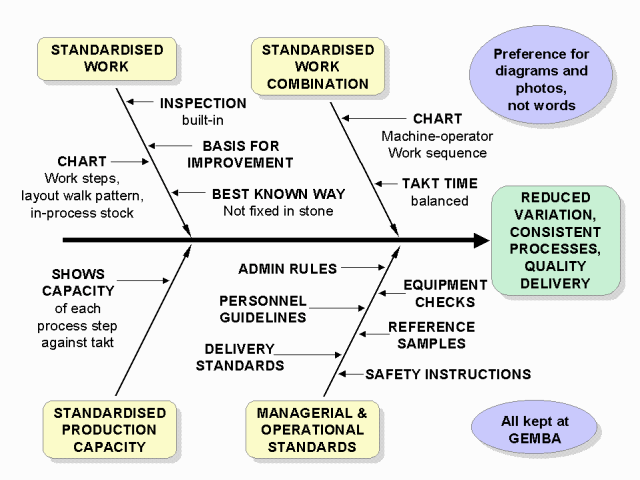
Lean and STANDARDS

Standards are the building blocks for Lean, for Six Sigma, and for the Supply Chain. Continuous Improvement needs to "hold the gains" (Juran) before moving forward, and standards prevent slipping backwards. We are not talking here about British Standards, MIL standars, ISO standards, Fire Standards and the like. Such standards tend to be fixed and given. We are talking here about operations standards - the current best, safest known way. Standards should be written by operators not work experts, revised whenever necessary, followed between revisions, be kept at the workplace (at Gemba), making best use of photos and sketches rather than words. There are generally four categories, the first three of which relate together to workplaces or cells.
Any time a standard is not being followed (for instance more than the standard inventory) this indicates that something unusual is happening. Action is called for.
STANDARDISED WORK charts set out the steps carried out by an operator in a process or in making a product. They include work steps, the layout walk pattern in the case of cells, and the standard in-process stock. Standardised work should allow time for inspection, but generally no allowance for rest and delay, which should be taken at specific intervals, not continually occurring at unspecified times.
STANDARDISED PRODUCTION CAPACITY turns standard times into the standard daily capacity. This is measured against takt time (customer's rate of demand).
STANDARDISED WORK COMBINATION charts are found in cells where operators tend several machines. The chart shows the time to load, unload and walk between the machines. Machine cycles are also shown. An operator must be able to complete his work cycle within the takt time. This is the Lean form of the 'man machine chart'.
MANAGERIAL AND OPERATIONAL STANDARDS are found at Gemba throughout the rest of the organisation. There may be standards for meetings, for agendas, for delivery, for safety, indeed for most things. This is safety, good management, order, and not bureaucracy.